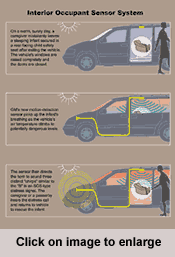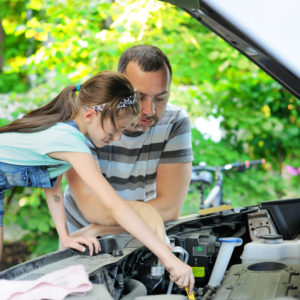
According to The National Safe Kids Campaign and General Motors, that is exactly what some parents do when they leave their child unattended in a car while they go off and run some errands. From 1996 through 2000, more than 120 children died from heat stroke because they were left in a vehicle by normally caring and well-intentioned parents or caregivers. More than 90 percent of these children were age three and younger.

Harried parents often believe that they can safely leave a child for a few minutes while they run to do a quick errand. In the real world however, delays are a fact of life and even a delay of a few minutes can spell disaster for a small child trapped in a closed car…
Some people don’t realize that, even on a mild day with temperatures in the 70’s, the interior of a vehicle can quickly rise to temperatures of 120 degrees or more. At 80 degrees outside temperature on a sunny day, an air conditioned interior that is 70 degrees when the vehicle is shut off, will reach better than 90 degrees in about 10 minutes, 120 degrees in 30 minutes and shoot past 130 degrees in an hour. GM has been doing extensive research on this problem. One of the things that it discovered is that cracking a window opened is of little help.


On April 26, 2001, GM announced that it will be developing a system that will actually detect an infant in a closed vehicle through a very sensitive motion detector built into the vehicle’s headliner. This sensor will see movement as small as a sleeping baby’s breathing, and sound an alarm if the interior temperature rises to unsafe levels. As an added benefit, this system will also work for pets that are left in a dangerously hot car. The details of this system are still in the developmental stages, but it is expected that GM will have a product available by 2004.
Some of the ideas that are being tossed around are to integrate this sensor with the vehicle’s security system in order to reduce costs. This would perhaps allow the system to detect an intruder lurking in the back seat and warn you as you approach the vehicle, perhaps by sending a signal to your remote transmitter.
GM has said that it will freely share their research with other manufacturers that are interested, but all the gadgets in the world are not going to insure your kids safety. That job rests squarely in the hands of you, the parents.
Keep your kids safe by following these simple rules:
- Teach children not to play in, or around cars.
- Never leave a child unattended in a motor vehicle, even with a window slightly open.
- Always lock your doors and trunk — even at home — and keep keys out of children’s reach.
- Watch children closely around cars, particularly when loading and unloading. Check to ensure that all children are accounted for when you leave the vehicle. Don’t overlook sleeping infants.
- Secure children in the rear seat in approved car seats. Use booster seats for larger children.
- If you own a 1990 or later GM vehicle, see if you can have it equipped with a trap resistant trunk kit at your nearest dealer
When restraining children in a car that has been parked in the heat, check to make sure that seating surfaces and equipment (car seat and seat belt buckles) are not overly hot.


A Message from the Humane Society of the United States
Any information provided on this Website is for informational purposes only and is not intended to replace consultation with a professional mechanic. The accuracy and timeliness of the information may change from the time of publication.















